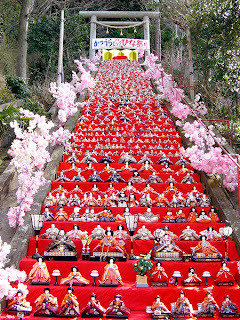Hinamatsuri is a celebration of a girl who is celebrated annually on March 3 in Japan which was help to pray for the growth of girls. Hinamatsuri derived from the word 'despicable' meaning princess or girls and 'Matsuri' which means celebration. The family whose daughter was displaying a set of dolls called hinaningyo.
One set consists of a stuffed doll emperor, empress, princess castle (a lady's maid), and the court musician who describes the traditional wedding ceremony in Japan. Clothes worn on the doll is a kimono style Heian period. This celebration is often called the Doll Festival or Girls Festival because the game originated among the princess doll called hiina asobi.
Brief History
Before the Japanese use the Gregorian calendar (calendar AD), Hinamatsuri celebrated on the day 3rd months 3rd according to the Lunisolar calendar. The day is also called no sekku momo (peach flower festival), because it coincided with the blossoming peach flowers. Start the Gregorian calendar used in Japan since January 1, 1873 so that the celebration of Hinamatsuri changed to March 3. However, some people still choose to celebrate Hinamatsuri Lunisolar calendar based on calculations (around April of the Gregorian calendar).
Although called Matsuri, is more a celebration of family gatherings at home, and just celebrated by a family who has a daughter. Before the day of celebration arrived, the children helped their parents out of the puppets storage box for display. The day after Hinamatsuri, dolls should be saved because it was believed to absorb evil spirits and bad luck.
But in a number of classical literature written about the habits of play dolls among girls royal palaces of the Heian period (around the 8th century). According to estimates, the doll is played with the dollhouse in the form of the palace. Game among girls is known as the despicable asobi (play doll princess). In principle, hina asobi is a game and not a ritual.
Starting around the end - 19th century (Edo period) until the beginning of the Meiji period (January 25, 1868), Hinamatsuri doll which originally consisted only of a pair of emperor and empress dolls developed into one complete set of the following dolls princess palace, musicians, and miniature castles, furniture Household and kitchen. Since then, the doll on display at the top dankazari (ladder for display), and people all over Japan began to celebrate hinamatsuri massive.
Composition Dolls
Dolls placed on a multilevel stage, called dankazari (ladder to display) is covered in red cloth. Number of steps varies, the more steps, more and more dolls. Parents in antiquity berlimba buy her a doll-contest the best, most expensive, and with the highest rung. The more steps also means getting rich family. Each doll is placed in a predetermined position based on tradition for generations. Dankazari stage backed with a thick blanket of red-called hi-mōsen.
One set of dolls are usually equipped with a miniature folding screen (byōbu) to be installed as a gold-colored background. On the left side and right-placed pair of miniature lanterns (bombori). Another device in the form of miniature cherry tree and the tree Tachibana, and cut branches of peach flowers as decoration.
· Top Appliances
Two dolls that symbolize the emperor (o-Dairi-sama) and empress (o-hina-sama) is placed on top of the stairs. In Japanese, Dairi means "emperor's palace," and abject means "princess" or "girls". Hinaningyo the most simple consisting only of these two dolls. Left-right sequence in the second laying of this doll is different in some areas. Some put the emperor on the right because the right is considered superior, but some say otherwise, but the arrangement of dolls in each of the next steps are always the same.
· Second Appliances
Three princess doll castle (san-nin kanjo) in second place on the ladder. Third daughter was carrying equipment palace drinking sake. Princess doll palace most middle to bring bowls of sake (sakazuki) who put on the shampoo. Two other castle princess doll carrying the pitcher of sake (kuwae no chōshi), and containers of sake (nagae no chōshi). One tooth blackened castle princess doll (ohaguro) and his eyebrows shaved off. In the puppet version of Kyoto, the middle daughter of the palace which took shimadai (decoration sign of happiness from the leaves of pine, bamboo leaves, and flowers ume).
· Third Appliances
In third place there were five male musicians doll (go-nin bayashi). The four musicians each carrying a musical instrument, except the singer who brought fan-fold. Musical instrument that brought the musicians are taiko, ōkawa, kotsuzumi, and flute.
· Fourth Appliances
In the fourth ladder placed two dolls minister (daijin) consisting of the Minister of the Right (Udaijin) and Minister of the Left (Sadaijin). Puppet Minister Right depicted are young, while the puppet Minister of the Left look older. From the viewpoint of the observer, the Minister of the Right is on the left, while the Minister of the Left is on the right.
· Fifth Appliances
In the fifth ladder placed three runners male doll (shichō). All three are each carrying a package containing a cap (daigasa) which was brought by a stick blade, shoes are placed on the tray, and long umbrellas in a closed state. Furthermore, cow train and a variety of miniature furniture used as a wedding gift is placed on top of the stairs beneath him.



Tidak ada komentar:
Posting Komentar